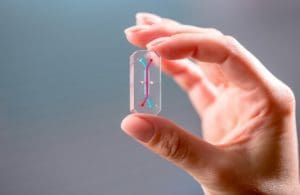
Emulate Bio’s CHIP-S1
While organ-on-a-chip technology has evolved tremendously over the past 15 years, adoption of the technology remains at an early stage. But as organ-chip technology advances and the R&D costs for pharma companies continue to hover near unsustainable levels, organ-on-a-chip technology has the promise to address what cell biologist and bioengineer Donald Ingber called the “broken” drug-development model.
One of the key challenges is the drug industry’s reliance on animal studies in preclinical research, Ingber said in an Emulate Bio virtual event. “There are ethical issues,” said Ingber, a member of the company’s board of directors. “But the real problem is that the results of these animal preclinical models often don’t predict clinical responses,” he added.
Complicating matters further is the rise of biologics, which make up a sizable portion of the drug-development pipeline. Non-human primates are frequently the only relevant animal model for biologics, such as monoclonal antibodies.
Yet such primates are in short supply. They are also expensive, costing multiple thousands of dollars per animal. Primate testing is also controversial.
And as drugs such as therapeutic antibodies and CRISPR RNA-based therapies advance, they become difficult to study in non-human primates.

A liver-chip diagram from Emulate Bio
Emulate Bio and other similar firms such as Hesperos, Netri and Tissue Dynamics are banking on organ-chips that can mimic human organ-level functions. The technology can “accelerate drug development, replace animal testing and also advanced personalized medicine,” Ingber said.
Organ chips can predict human responses for drugs using clinically relevant dose exposures. The technology can also mimic the body’s pharmacokinetic profiles.
The market size for organ-on-chip technology could quadruple from 2020 to 2025, according to a recent report.
For now, scientists are still divided on whether organ-chips are ready for prime time. A paper published last year in Biomicrofluidics pegged organs-on-chip as a developmental technology. Using the nine-tiered Technology Readiness Level scale, the authors concluded the technology was at level four. An emerging technology is ready for real-world applications at level nine. Yet the technology has “high potential to revolutionize many medical and industrial sectors, particularly in preclinical-to-clinical translation in the pharmaceutical arena,” they concluded.